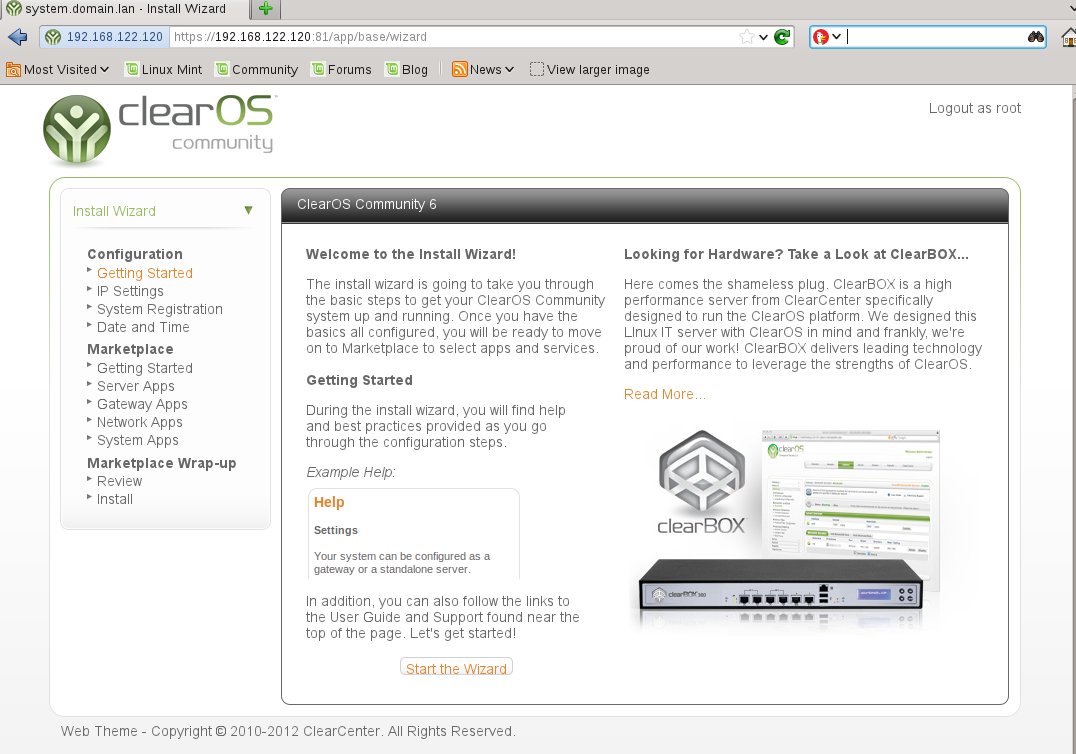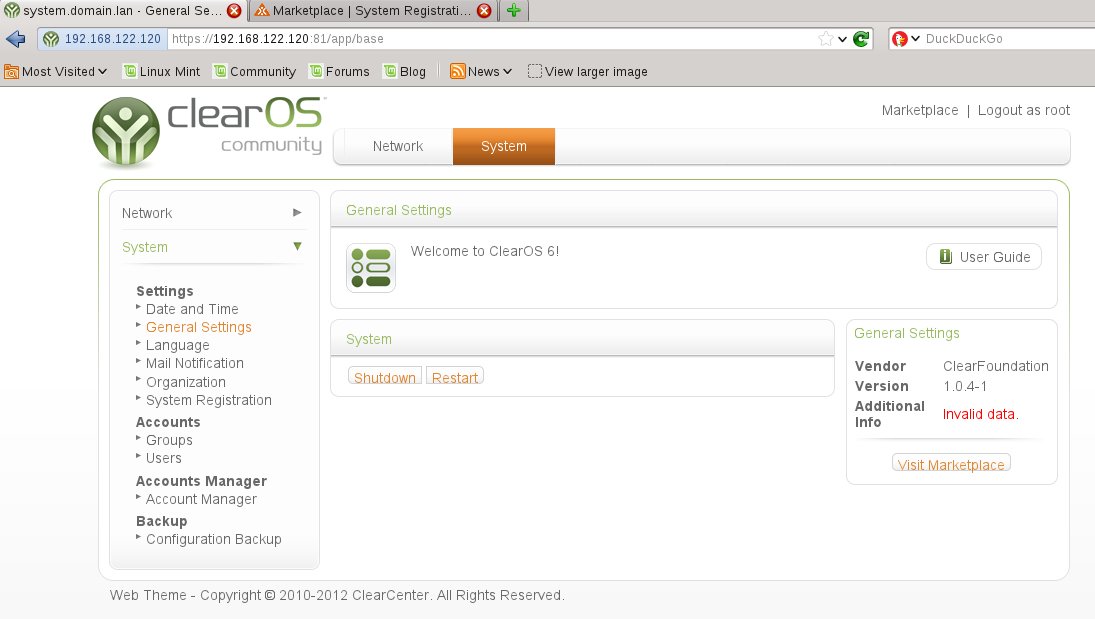There is a recurring lament that there are no Linux distributions equivalent to Windows Small Business Server, no nicely-integrated Linux LAN server that doesn’t need a lot of tweaking. But there is one that is billed as a drop-in replacement for SBS, and that’s ClearOS.
Linux is a flexible powerhouse in the server room, but is sometimes criticized for not being like Windows Small Business Server. This is a good thing, because making Linux worse doesn’t make sense. But the idea of SBS is a good one, a nicely-integrated LAN server that can be up and running with a minimum of fuss, and Linux does have one of those: ClearOS. Let’s take a look at ClearOS 6.2 beta 3, which is the current release.
ClearOS 6.2
ClearOS used to be named ClarkConnect. It was built on Red Hat Enterprise Linux and CentOS. The current stable release is 5.2, which tracks RHEL 5.2. There are no point releases after that, even though RHEL has had multiple point releases (5.3, 5.4 and so on) leading up to the 6.0 release. RHEL 6.2 was released in December 2011. ClearOS 6.2 beta 3 came out February 29. So what’s up? A lot. The maintainers have given it a major overhaul, which will be revealed in all of its glory in the final 6.2 release, which is scheduled for “soon”.
The Webconfig development framework has been overhauled for speed and more extensibility. A lot of effort has been invested in documenting the ClearOS development process with the goal of making it easier for new developers to come on board. The new ClearCenter Marketplace is the ClearOS app store, a place for outside developers to distribute their wares, both paid and free.
Another major change is adding more functionality. ClarkConnect was built more for firewall/Internet gateway duties, though it also included a batch of common servers like Web and mail. The 6.x series uses RHEL as its base, then adds an excellent Web-based graphical administration interface, and a number of other servers and applications to make a complete fully-featured LAN server.
There are two editions: Community and Professional. Both share a common base. The Community edition is all free/open source software and free of cost. The Professional edition costs money and has a number of optional paid options such as various levels of tech support, and a batch of applications not included in the Community edition:
- Active Directory Connector
- Google Apps Synhcronization
- Kaspersky Anti-malware
- Zarafa Small Business
- Central Management
Though any of these can be added the Community Edition after installation. ClearOS is maintained by the ClearFoundation, which is based in New Zealand. The Foundation has noble goals:
- Ensure that every small organization and distributed IT environment on the globe can have proper security, filtration, and management;
- To defend Open Source software as publicly available and freely distributed: namely, ClearOS and its open source components;
- To promote the development, enhancement, and application of Open Source software within ClearOS;
- To ensure that people of any language and ability can use ClearOS for their own purpose.
It is privately-funded, and earns revenues through the sales of services and support.
Where is Everyone?
Installation, as with all modern Linux distributions, is fast and easy. Currently there are only ISO images for installing from a CD. ClearOS runs headless, but you’ll need an attached keyboard and monitor for installation. The installer sets an IP address like 192.168.122.120, so the first screen after first login lets you change it. Once you’ve sorted that out you’ll access your new ClearOS server from a Web browser. Figure 1 shows the first post-installation Web screen. 
You have to follow the wizard on a fresh installation, and will be required to register your server by creating a Marketplace account. It’s fast and easy, though the idea of being required to do this is a bit annoying. After registration it steers you to the paid Marketplace apps. There isn’t a way to avoid this that I could see, and I got stuck and couldn’t get out of it. I tried logging out and then back in to try again, and after bumbling around finally got out of the Marketplace and into an administration menu. This looks incomplete, as Figure 2 shows: 
There is no system status, no way to install applications, few configuration pages, and most of the User Guide buttons give 404 errors. I’m not a fan of sending users to an external site for help pages anyway; what do you do when your network is down? There are no free-of-cost applications in the Marketplace, and the Marketplace filters don’t work right.
I’m not against paying for software, but the Web interface has no other way to install software, so I expected this would be done via the Marketplace and it would include all available packages. The page indicated that 77 apps were in the Marketplace, but it wouldn’t show me more than 52. All I wanted was a list all on one page, but it wouldn’t do that either.
One feature that did work was the built-in OpenLDAP directory. All it took was a button click to initialize it, and then I could create new user and group accounts.
I tried the console on my test server, and that also had extremely limited functionality: launch the graphics mode console, which only configures network settings, run IPTraf, or shutdown. Fortunately ClearOS started an SSH server by default, so I could open an SSH session and see what it was doing. And just exactly what was it doing? dnsmasq, sshd, postfix, webconfig, slapd (OpenLDAP), ncsd (name server cache), and winbindd (resolver for hostnames from Windows servers) were all running.
It all seemed rather random, and if I wanted to run everything from a bare console I wouldn’t be using ClearOS, so it appears there is still a lot of work to do before the final release. Once you get to a command-line it’s like any Linux, and you can install and remove software, and configure and control services.
Another problem with the Web interface is no home button, so I kept getting lost, and getting a bit irritated at the relentless flogging of the Marketplace. This is not the ClearOS of old, which has a well-organized and comprehensive Web administration interface.
On the bright side, I took a quick look at system resource consumption, and ClearOS acquitted itself well. The default installation uses about a gigabyte of disk space. With all those services running it used about 660MB RAM, and CPU usage was near zero. This may sound like a so-what bit of data, but any operating system running at idle should not be using much RAM or CPU, and yet many of them do.
Wait
I like ClearOS 5.2 a lot, and I’m a little disappointed that this release is still so far from completion. If you visit the 5.2 live demo you’ll see how far 6.2 has to go. There’s nothing wrong with 5.2, and I recommend it highly. When 6.2 is finally completed I expect it will be even better.





